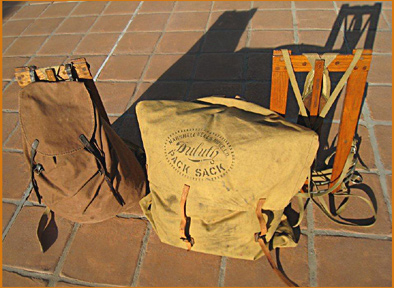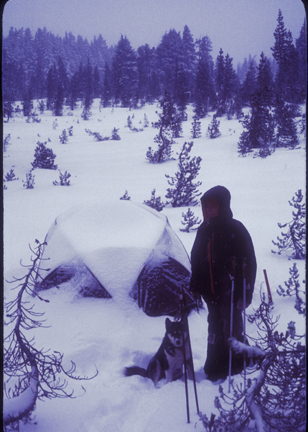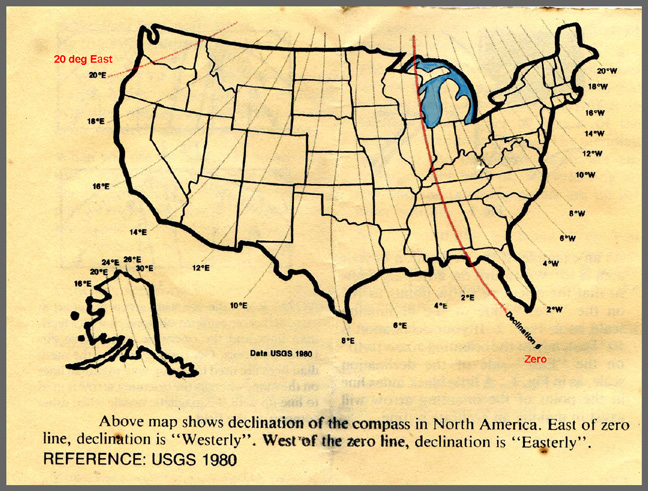

 Enormous progress has
been made in outdoor gear since the 1920s, when sturdy hikers
carried these kind of back-breaking packs. But even back then,
you can be sure that some version of the TEN ESSENTIALS
was carried by every knowledgeable hiker.
Enormous progress has
been made in outdoor gear since the 1920s, when sturdy hikers
carried these kind of back-breaking packs. But even back then,
you can be sure that some version of the TEN ESSENTIALS
was carried by every knowledgeable hiker.
No hiking or climbing site should be without a listing of the Ten Essentials... I present my listing below. It is directly based upon the version listed by the Washington Trails Association (WTA, found at www.wta.org).
The Ten+ Essentials: an expanded version by Bruce Johnson:
--Before beginning, here is an important warning for the Smartphone generation. It's something that our mountain rescue groups have been alarmed about for years--- do not count on your cell phone to get you out of trouble! Cell reception in remote areas is notoriously poor, the batteries die, especially in winter weather, the phones are sensitive to water damage, and to shock damage-- as when you fall into an icy river, or off a cliff and then lay there needing a rescue. If you want something more useful, buy a device that uses satellite location and is purpose-built, such as a SPOT unit.
A second note: "ten" essentials is only a minimum; eg. for winter travel in snow country, travel in bear country, and for major mountain climbs summer or winter, there are additional "Essentials," a fact that is important to note here at the outset.
**********************************************************************************************
1. Map - Always carry a detailed map of the area that you
are hiking in.
A map is one of the ten essentials. Always carry a map of the
area that you are hiking in.
The 15' Green Trails maps are great if you're staying on trail.
If you're planning on leaving the trail it's best to have 7.5'
USGS maps. Both kinds are available at most sporting goods stores.
Keep your maps in a plastic bag to protect them from the rain
and know how to use them. You would be shocked about how
many hikers truly do not know how to read/interpret maps and correlate
them meaningfully to the terrain they are facing. Interpreting
maps is a well-honed skill.
2. Compass - A map is no good without a compass and a compass
is no good if you don't know how to use it. It doesn't matter
how fancy your compass is, but if it doesn't have a compensation
setting for true North, make sure you know how to convert magnetic
to true North. In Western Washington magnetic North is 19-21°
east of true North. GPS units are great, but they are not substitutes
for knowing how to use a map and compass because they are devices
and can break, get waterlogged or seize up in cold weather. The
GPS can point you in the right direction, but it's the map that
tells you if you can safely go that way. Here's a link to a map of the United
States which shows you the amount of magnetic declination compensation
you will need in each area of the U.S.
3. Water and a way to purify It - It is essential to drink
a lot of water while hiking. Without water, your body doesn't
perform as well and you could grow more susceptible to heat stroke,
hypothermia and altitude sickness. In the halcyon days of yore,
you could just dip your bottle into a stream and drink the water.
Not today. All water sources can harbor tiny organisms that would
make your life extremely unpleasant later. You should purify all
water with a water filter or UV purifier, chemical tablets or
boiling before drinking.
4. Extra Food - Always bring extra food when hiking in
case an unexpected situation delays your return - be it detour,
injury or sickness, difficult terrain, weather, etc. Bring at
least one extra day's worth. It should be something that stores
for a long time, requires no preparation and is high in energy.
Many people choose things they really dislike so they won't be
tempted to break into their emergency rations unless they really
need them.
5. Rain Gear, Wind Gear and Extra Clothing - Weather can
change quickly in the mountains. A sunny, warm day can turn into
a cold downpour in a very short period of time. Always tuck rain
gear into your backpack and bring along extra layers of warm clothes.
And avoid cotton clothing in favor of wool or poly blends that
wick moisture away from your skin. A cap for your head is crucial--a
cap is light, compact and provides insulation for your body's
most vulnerable source of heat loss in survival situations-- it
should be made of wool or synthetic polarfleece material. Wind
can also be a killer, even with no rain or snow accompanying it,
so be certain that your extra clothing includes some type of windbreaker,
like a hooded nylon anorak.
6. Firestarter and Matches - Always bring along waterproof
matches in a water-tight container and have a dry or waterproof
striker. You might also bring a cigarette lighter as a backup.
And in the Northwest you can expect to have to deal with wet kindling.
A candle, solid chemical fuels or balls of compressed wood chips
work well. Especially good are the tools which combine a flint
with a magnesium bar. See my page about this subject at:
http://www.oregonphotos.com/Fire-firestarting.html
7. A well-stocked
first-aid kit has more than just band aids. One good example:
modern ER medical practice includes using Super Glue to
patch up minor cuts and wounds! The glue repairs are even pretty
waterproof. Another example: older hikers and folks in general
who are pushing the limits in mileage commonly take Ibuprofen
(NSAID) both preventively and post-hike to deal with the pain
that comes with heavy exercise....For foot care, of course you
carry something like Moleskin, but did you forget an adequate
pair of sissors to cut it to size?
- Don't just have a first aid kit, have a useful first
aid kit. If your kit just has a few bandaids and some aspirin,
you won't be able to do much. Make sure you have the supplies
to deal with major injuries, and make sure you have the knowledge.
You can purchase hiker first aid kits at outdoor stores or put
together your own (see WT Magazine). Take a first aid course from
the Red Cross or the Mountaineers or the Mazamas.
8. Knife or Multi-Purpose Tool - Knives are indispensible
in the backcountry. They can help you prepare food, cut Moleskin
or bandages, repair gear, safety in terms of self-defense, and
more. Do you need a giant Bowie knife, or just a modest folding
knife or a 15-tool Swiss Army knife? My main suggestion is just
be sure it is adequately sharp so it will do its job.
9. Flashlight and extra batteries - It's dark out there!
A light source is vital if you get caught in the woods after dark.
Also carry spare batteries and an extra bulb and make sure you
test your light before each trip. Batteries have a limited shelf-life,
and contacts can become corroded blocking the flow of current.(Note:
modern flashlights nearly all use LEDs, not bulbs, and there are
no spares to be carried; so it is best to just carry an entire
backup flashlight or headlamp). If you're headed into hard-core
winter cold, spend the extra money to buy and use LITHIUM
batteries.
10. Sun screen and sun glasses - Your eyes need protection,
especially if you are on snow or above treeline. Sunglasses are
a must. And those rays are strong and damaging; sunscreen is important
for people of all skin types. A hat with a good brim is highly
recommended and provides protection that doesn't wash off with
sweat or rain.
---In addition to these items, know your limits and be sure you always leave an itinerary with friends or relatives.
And a few other items you should consider adding to your
pack--- insect repellent, whistle, watch, emergency blanket, mirror
(for signaling), duct tape (great for repairing anything, including
boot soles that try to peel off), gloves, extra socks, and an
orange vest (during hunting season). GPS and/or altimeter. (and
use Lithium batteries for all battery powered gear to be
used under severe cold (below 20 degrees F).
Safety: in bear or cougar country, carry bear spray and cannister for your food if overnight. If in snake country, consider "snake boots." And in general in the out-of-doors, carry a decent knife with at least a 3 or 4 inch blade.
(image at page top): three 1920s-era packs, all made or sold in Portland, Oregon--- a "Duluth" pack sold at famous Portland hardware store Marshall-Wells Hardware Co.; and two "Wy'Easter" brand packs, made in Portland. Image credit: Peter Ireland
